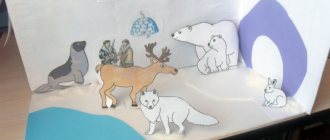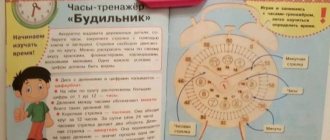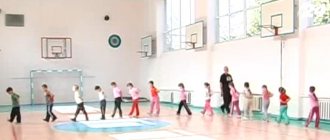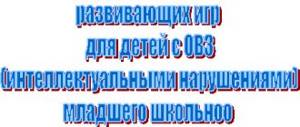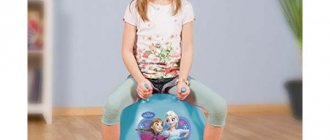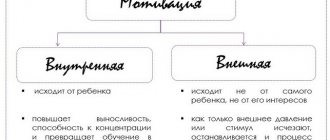Structure and content of the program
The comprehensive program “Childhood” is aimed at creative self-realization and the development of independence in preschool children.
The structure of the Program is represented by the following educational areas:
- Cognitive development
- Social and communicative development
- Physical development
- Speech development
- Artistic and aesthetic development
The main goal of the Program is to create optimal conditions that provide each kindergarten student with the opportunity to fully interact with the outside world through various types of activities.
The content of the Program in accordance with the Federal State Educational Standard for Education assumes:
- The presence of three sections: target, content and organizational.
- Having an idea about the peculiarities of organizing the educational process in different age groups.
- Characteristics of the developmental characteristics of preschool children and the expected results of mastering the Program in different age groups.
- Setting objectives and expected results of mastering the Program, and on their basis filling out the content for each educational area in each age group.
- Disclosure of the features of play and play activity as a special developmental space for a preschool child.
- Description of variable forms, methods, means and means of effective implementation of the Program.
- Description of the features of educational and other activities of children, depending on their age.
- Main directions and ways to support children's initiative.
- Features of the organization of pedagogical monitoring and diagnostics.
- The characteristics of the interaction between the teaching staff and the student’s family are given.
- The necessary methodological recommendations for designing the main educational program of a preschool educational institution are presented.
- The content of teaching materials, as well as the basic methods and means of education and training, are determined.
- The daily routine for each age group is presented, as well as the daily routine for the period of children’s adaptation to the conditions of the preschool educational institution.
- The features of conducting traditional preschool educational activities and the features of organizing the subject-developmental environment of the group are revealed.
- The Programs Appendix contains sample partial educational programs.
Finished works on a similar topic
- Course work Comprehensive program “Childhood” 460 rub.
- Abstract Comprehensive program “Childhood” 280 rub.
- Test work Comprehensive program “Childhood” 240 rub.
Receive completed work or specialist advice on your educational project Find out the cost
The principles on which the Program is implemented:
- Principle of education and development
- The principle of preserving and strengthening the health of pupils
- The principle of cooperation with the student’s family
- The principle of introducing children to social and cultural principles
- The principle of relying on the traditions of family, society and state
Features of the Program content
The main feature of the Program is that its content is person-oriented and aimed at developing a humane attitude in children towards the world around them.
The program is aimed at meeting the most pressing needs of modern preschoolers, through their interaction with different spheres of culture (fine arts, music, native language, etc.). It is this extensive and varied content of the Program that is the basis for the full and comprehensive development of children’s creative and cognitive abilities, their natural inclinations and interests at all stages of preschool childhood.
Each section of the Program involves the operation of one general mechanism:
Too lazy to read?
Ask a question to the experts and get an answer within 15 minutes!
Ask a Question
- Introducing children to a specific cultural area or object.
- Children's fascination with a given area or object.
- Each student masters the necessary skills and abilities that allow self-realization in a given cultural area and satisfy their own individual needs.
- Children demonstrate independent creative activity through acquired skills and abilities.
- Creating the necessary conditions for children’s emotional acceptance of aesthetic and moral values.
Note 1
Thus, each pupil receives his own sociocultural experience, which becomes the foundation for the further full development of the child and his readiness for schooling.
Analysis of the programs “Rainbow”, “Development”, “Childhood”, “2100”
CONTENT
RAINBOW PROGRAM.. 3
CHILDHOOD PROGRAM.. 4
DEVELOPMENT PROGRAM. 7
PROGRAM 2100. 9
Authors: Professor of the Department of Preschool Pedagogy and Psychology at Moscow State University of Psychology and Education Doronova T.N., Gerbova V.V., Grizik T.I. and etc.
The authors of the program note that the success of learning in mathematics classes largely depends on the presence of interest in them. Cognitive interest in mathematics is a child’s selective, positive, emotionally charged attitude towards mathematics, manifested in a preference for this type of activity over others, in a desire to gain more knowledge in mathematics, and to use it in independent activities.
The “Rainbow” program in terms of the content of teaching mathematics to children differs from traditional ones in the large amount of knowledge, especially in older preschool age, where some of the material included in the program of primary and even secondary school mathematics education is offered for study with children.
A characteristic feature of the “Rainbow” program is its methodological support (Guide for Educators), which distinguishes it favorably from the “Program of Education and Training in Kindergarten”, the imperative nature of which can be seen on each of its pages. The Rainbow program not only defines the tasks of working with children, but also the main ways to implement them.
We consider the merit of the authors of the Rainbow program; a) creating an atmosphere of psychological comfort and emotional well-being of the child; b) giving him the right to choose a form of independent activity: c) organizing education in a preschool educational institution in the context of the formation of the child’s personality; d) focusing the teacher’s attention on the formation of trusting relationships with children in the process of joint activities with them.
Authors: V. I. Loginova, T. I. Babaeva, N. A. Notkina and others.
In the “Childhood” program, a central place in the development of elementary mathematical concepts in children of the senior and preparatory groups is occupied by initial mathematical development, which includes the ability to observe and compare, juxtapose, analyze, and perform simple arithmetic operations.
Children's familiarization with the world around them begins with studying the properties and characteristics of objects. Mastery of such properties and relationships of objects as color, shape, size, spatial arrangement allows a preschooler to freely navigate different types of activities. In this regard, the following tasks of children’s mathematical development are solved:
· Develop children's emotional responsiveness through games with mathematical content.
· Form a system of mathematical knowledge, skills and abilities in accordance with the psychological characteristics of children of each age group.
· Form logical thinking techniques (comparisons, generalizations, classifications).
· Develop independence of cognition, encourage the manifestation of creative initiative.
· Develop fine motor skills and hand-eye coordination.
In preschool age, the child's leading activity is play. In this regard, taking into account the age characteristics of children, all types of classes are conducted in the form of a game or with the content of a game situation, using a character (toy). Game methods and techniques help to successfully implement the first task , since the game has a positive effect on the formation of the emotional sphere of the preschooler. For example, the following game plots are interesting for younger preschoolers: “A trip to the forest to see a squirrel”, “The Magic Box”, “Visiting the Old Forest Man”, “Three Bears”, “Teremok”. For children of older preschool age, the plots become more complex: “Space Travel”, “At the Toy Factory”, “The Kingdom of Mathematics”. Other characters come to visit the children: Pinocchio, Dunno, Ole Lukoie, The Snow Queen, etc.
When creating a game situation, it is necessary to attract children’s attention and hold it; stimulate interest in the lesson and the material being studied. To solve the second and third problems, didactic games play a special role, the use of which as educational material makes it possible to teach children to compare objects, contrast them, highlight common features, make simple classifications, and also solve other educational problems in a playful way. Children especially like activities using Dienesh blocks, Cuisenaire sticks, educational games: “Fold the pattern”, “Unicube”, “Cubes for everyone”, “Tangram”, “Fractions”, “Magic Circle”, various puzzles, labyrinths. When choosing didactic material, games, and teaching aids, it is necessary to take into account the characteristics of children at different levels of development, which helps to make the necessary correction for positive progress in the development of each child. Classes are conducted in subgroups of 10 - 12 people.
I build each lesson according to the following principle: each previous and subsequent one has common elements - material, methods of action, results. They are brought closer together in time or exercises are given simultaneously to master interconnected and reciprocal methods of action (overlays - applications, relationships greater - less, higher - lower, wider - narrower). Formed ideas and mastered actions are used in a variety of activities, for example: inviting children to take a certain number of nuts and treat the squirrels, or determining the number of circles on a card, or finding the same number of objects in a group room.
One of the main methods of forming elementary mathematical concepts is asking children questions. In elementary and middle preschool age, these are reproductive-mnemonic (How many? What is the name of this figure? What is the difference between a square and a triangle?). At an older age, reproductive-cognitive questions are asked (What needs to be done so that there are five circles?). Problem-search questions (What do you think?) are used for children of any age. At the same time, the volume of material that the child owns is taken into account, thereby implementing an individual approach to each preschooler. All these questions activate children’s perception, memory, thinking, and speech, ensuring comprehension and assimilation of the material.
Particular attention is paid to the development of independence, resourcefulness, and intelligence in children. This is facilitated by educational games and tasks to develop the skills of comparing, generalizing, analyzing, and making logical conclusions. In games and tasks for the development of logical thinking, children are attracted by the unusual setting of the problem and the way it is presented.
In accordance with the program, it is necessary to develop in children the ability to navigate in space, to simply imagine the spatial placement of objects in relation to themselves, for example: “Determine where the house is located - at the very end of the path coming from the child, in front or behind, on the right or left” and etc.
Children who have difficulty mastering the material are given individual work in the afternoon.
To develop elementary mathematical concepts, the group has a large selection of didactic and educational games: “Part and Whole”, “Fractions”, “Magic Squares”, “Lotto - Count”, “Geometric Mosaic”, “Time Interval Models”, etc.
Authors: L. A. Wenger, O. M. Dyachenko, N. S. Varentsova and others.
Most adults interested in their child's development try to help him take his first steps in mathematics.
Not being specialists in the field of preschool education, they strive to immediately teach the child to count and solve problems.
But is this where we need to start?
In mathematics, the main thing is to teach how to think, reason logically, find mathematical relationships and interdependencies hidden for direct perception, etc.
That is why, according to the authors of the program, one should start not with counting, but with an understanding of mathematical relationships: more, less, equally. This is the so-called pre-numerical period of learning, when the youngest preschooler, not yet familiar with numbers, already comprehends quantitative relationships, comparing objects by size (length, width, height), comparing two groups of objects, first directly, and then indirectly, with the help of visual models, allowing to give the child not only specific, but also generalized knowledge.
The use of visual models of various types (a model of two groups of chips arranged according to the principle of one-to-one correspondence, a children’s abacus made of two lines of bones, a model in the form of intersecting circles or ovals, a “logical tree” model, etc.) will help the child subsequently gain a complete understanding about the number, about neighboring numbers, about the transition from one number to another, about the number series, about the composition of numbers from 3 to 10, will facilitate the understanding and solution of arithmetic problems.
This path of mathematical development of a child, on the one hand, will make it possible to generalize children’s ideas (use them to solve a wide range of problems), on the other hand, it will teach them to identify the signs that are essential for each cognitive task, to perform the necessary mental actions, i.e. will develop their mental abilities.
This program is aimed at developing logical and mathematical concepts and skills in a playful way. Children are introduced to new materials on the basis of an active approach, comprehended through independent analysis, comparison, and identification of essential features. Development of variable and imaginative thinking, creative abilities of children. A special role is given to non-standard didactic means.
For preschool children, play is of exceptional importance: play for them is study, play for them is work, play for them is a serious form of education. Game for preschoolers is a way of learning about the world around them. The game will be a means of education if it is included in the holistic pedagogical process. By directing the game, organizing the life of children in the game, the teacher influences all aspects of the development of the child’s personality: feelings, consciousness, will and behavior in general.
However, if for the pupil the goal is in the game itself, then for the adult organizing the game there is another goal - the development of children, their acquisition of certain knowledge, the formation of skills, the development of certain personality qualities. This, by the way, is one of the main contradictions of the game as a means of education: on the one hand, there is no goal in the game, and on the other, the game is a means of purposeful personality formation. This is most evident in the so-called didactic games.
The nature of the resolution of this contradiction determines the educational value of the game: if the achievement of a didactic goal is achieved in the game as an activity that contains the goal in itself, then its educational value will be the most significant. If the didactic task is solved in game actions, the purpose of which for their participants is this didactic task, then the educational value of the game will be minimal. A game is valuable only if it contributes to a better understanding of the mathematical essence of the issue, clarification and formation of students’ mathematical knowledge. Didactic games and play exercises stimulate communication, since in the process of these games the relationships between children, child and parent, child and teacher begin to be more relaxed and emotional.
1.These are counting sticks - they are used to introduce the child to shapes. Children build and transform simple and complex figures according to conditions. Puzzles are offered to children in a certain sequence: make two equal triangles from 5 sticks. Make two equal squares from 7 sticks. Make 2 squares and 2 triangles from 9 sticks. Further, the nature of the tasks for forming figures becomes more complicated. For example: in a figure consisting of 9 squares, remove 4 sticks to leave 5 squares.
2.Coding, schematization and modeling of the simplest mathematical objects and properties. These are the games “Logic tables”, “What’s extra”, “Find a figure”, “Symbols”, “Tables”. These games teach you to use tables and indicate the properties of objects using symbols.
3. Riddles of mathematical content are used. They provide invaluable assistance in the development of independent thinking, the ability to prove the correctness of a judgment, and mastery of mental operations (analysis, synthesis, comparison, generalization.)
When guessing problems with mathematical content, children are happy if they answered correctly. After all, solving riddles is a thought process.
But it’s not enough to just guess. Each riddle is also a logical problem, in solving which the child must perform complex mental operations.
4. Children are invited to play puzzle games. The essence of the game is to recreate the silhouettes of objects on a plane according to an image or design. “Tangram” - children post silhouettes of animals, people, and household items. “Columbus Egg” - silhouettes of birds; they independently come up with the figures of warriors and ballerinas. "Pythagoras" - silhouettes of animals. These games are widely presented in the book “Game-based entertaining tasks for preschoolers” by Z.A. Mikhailov, “Mathematics before school” - the library of the “Childhood” program.
5.Joke problems are solved. The structure, content, and question in these problems are unusual. It only indirectly resembles a mathematical problem. The essence of the task, i.e. the main thing, thanks to which you can guess the solution, find the answer, is disguised by external conditions. For example: 1) You, me, you and me, how many of us are there in total? (two). 2) How to use one stick to form a triangle on the table? (put it on the corner of the table).3) How many ends does the stick have? Two sticks? Two and a half? (six)
6.Educational games in mathematics activate children's attention and consolidate acquired skills and abilities. So, for example, in the game “Hide and Seek” you call a chain of numbers, skipping a few of them. The children's task is to name the missing numbers. In this game, the child easily learns the number series and develops attention.
